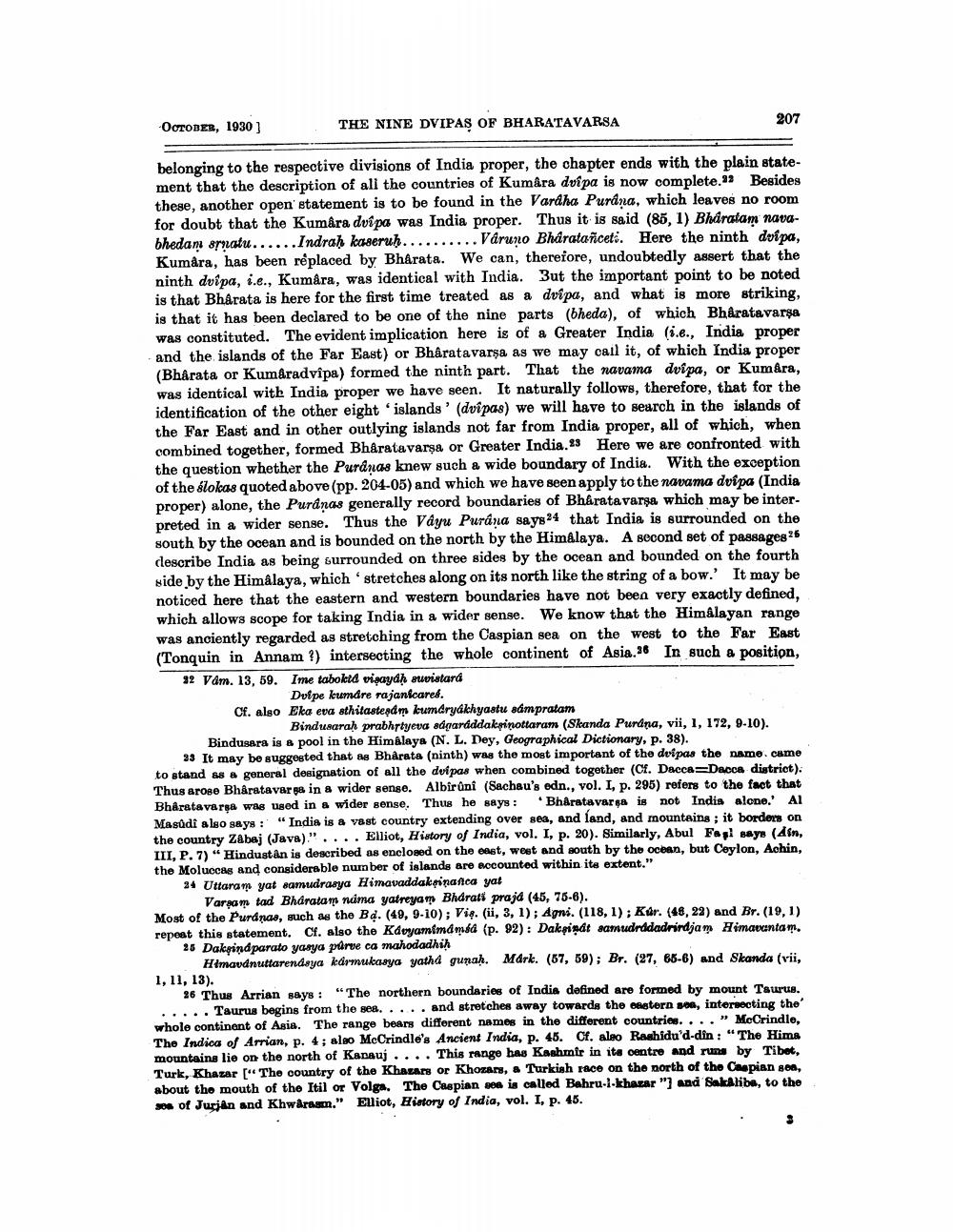________________
OCTOBER, 1930 ]
THE NINE DVIPAS OF BHARATAVARSA
207
belonging to the respective divisions of India proper, the chapter ends with the plain statement that the description of all the countries of Kumara dvipa is now complete. 23 Besides these, another open' statement is to be found in the Vardha Purana, which leaves no room for doubt that the Kumâra dvipa was India proper. Thus it is said (86, 1) Bharatam navabhedan ernatu...... Indrah kaseruh.......... Våruno Bhdrataniceti. Here the ninth dvipa, Kumara, has been replaced by Bharata. We can, therefore, undoubtedly assert that the ninth dvipa, i.e., Kumara, was identical with India. But the important point to be noted is that Bharata is here for the first time treated as a dvípa, and what is more striking, is that it has been declared to be one of the nine parts (bheda), of which Bharatavarga was constituted. The evident implication here is of a Greater India (ie., India proper and the islands of the Far East) or Bharatavarşa as we may call it, of which India proper (Bharata or Kumaradvîpa) formed the ninth part. That the navama dvipa, or Kumara, was identical with India proper we have seen. It naturally follows, therefore, that for the identification of the other eight 'islands' (dvipas) we will have to search in the islands of the Far East and in other outlying Islands not far from India proper, all of which, when combined together, formed Bharatavarşa or Greater India. 23 Here we are confronted with the question whether the Purdnas knew such a wide boundary of India. With the exception of the slokas quoted above (pp. 204-05) and which we have seen apply to the navama dvipa (India proper) alone, the Puranas generally record boundaries of Bharatavarşa which may be interpreted in a wider sense. Thus the Vayu Purana says24 that India is surrounded on the south by the ocean and is bounded on the north by the Himalaya. A second set of passages 25 describe India as being surrounded on three sides by the ocean and bounded on the fourth wide by the Himalaya, which stretches along on its north like the string of a bow.' It may be noticed here that the eastern and western boundaries have not been very exactly defined, which allows scope for taking India in a wider sense. We know that the Himalayan range was anciently regarded as stretching from the Caspian sea on the west to the Far East (Tonquin in Annam ?) intersecting the whole continent of Asia. 36 In such a position, 32 Vám. 13, 59. Ime taboked viņaydḥ swistard
Dufpe kumdre rajanicares. Cf. also Eka eva sthitasteşam kumdryákhyastu sampratam
Bindusarah prabhtyeva sagaráddakrinottaram (Skanda Purana, vii, 1, 172, 9-10). Bindusara is a pool in the Himalaya (N. L. Dey, Geographical Dictionary, p. 38). 33 It may be suggested that as Bharata (ninth) was the most important of the dulpas the name, came to stand as a general designation of all the deipas when combined together (Cf. Dacca=Dacca district). Thus arose Bharatavares in a wider sense. Albirúní (Sachau's edn., vol. I, p. 295) refers to the fact that Bhârstavarna was used in a wider sense. Thus he says: 'Bharatavara is not India alone.' Al Masûdî also says: "India is & vast country extending over sea, and land, and mountains ; it borders on the country Zabej (Java).".... Elliot, History of India, vol. I, p. 20). Similarly, Abul Falseye (Amn, III, P. 7) “Hindustan is described as enclosed on the east, weet and south by the ocean, but Ceylon, Achin, the Moluccas and considerable number of islands are accounted within ita extent." 24 Uttaram yat samudrasya Himavaddakrinanca yat
Varşam tad Bharatam ndma yatreyam Bhdrati prajd (45, 75-6). Most of the Purdnas, such as the Bd. (49, 9-10); Vię. (ii, 3, 1); Agni. (118,1); Kur. (48,22) and Br. (19.1) repeat this statement. Cf. also the Kdoyamimamsa (p. 92): Daksinat samudrddadrindjam Himarantam.
25 Dakpinaparato yasya purse ca mahodadhih
Himavdnuttarendaya kármukasya yath gunah. Mark. (57, 59); Br. (27, 65-6) and Skanda (vii, 1, 11, 13).
26 Thus Arrian says: “The northern boundaries of Indis defined are formed by mount Tsurus. ..... Taurus begins from the sea..... and stretches away towards the eastern sem, intersecting the whole continent of Asia. The range bears different names in the different countries...." McCrindle, The Indica of Arrian, p. 4; also McCrindle's Ancient India, p. 45. Cf. aleo Rashidu'd-din : "The Hima mountains lie on the north of Kanauj.... This range has Kashmir in its centre and runs by Tibet, Turk, Khazar ("The country of the Khazars or Khozans, a Turkish race on the north of the Caspian sen, about the mouth of the Itil or Volga. The Caspian ses is called Bahru-l-khazar ") sad SakAlide, to the son of Jucjan and Khwarasm." Elliot, History of India, vol. I, p. 45.




